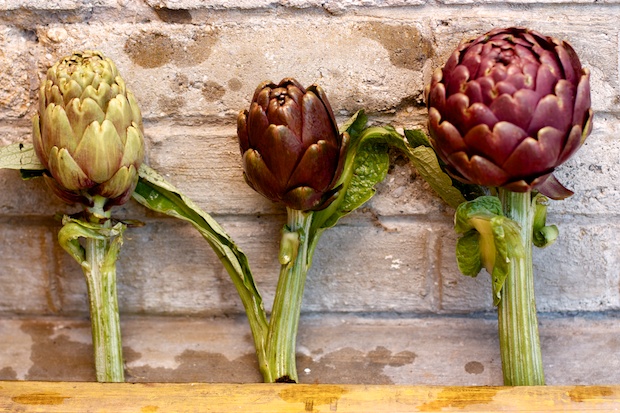This post is also available in: English
Per l’acquisto i carciofi non devono presentare macchie scure, per riconoscere la freschezza bisogna stringere con le dita il carciofo che deve risultare ben sodo.
Quelli molli risultano più amari e stopposi.

E’ un ortaggio ideale per prepararsi alla primavera.
Infatti le sue proprietà depurative sono un toccasana per ripulire sangue e fegato dopo il periodo invernale.
Il carciofo ha un buon apporto di fibre.
Contiene potassio, magnesio, fosforo, ferro, calcio e vitamina B1.
E’ una pianta mediterranea coltivata soprattutto in Italia, Francia e Spagna.
Si dice che Caterina de Medici abbia fatto conoscere i carciofi, portati dalla sua Toscana, alla corte Francese dove era andata in sposa a Enrico II, nel 1533.
I conquistatori Spagnoli e Francesi ne diffusero la coltivazione in California e Luisiana.
Negli ultimi anni anche il Perù ha iniziato una vasta coltivazione di carciofi, diventando un grande esportatore.
In Italia si fa grande uso di carciofi anche perché siamo il più importante produttore al mondo.
Quasi il 50% del prodotto mondiale è italiano.
I carciofi si dividono in due grandi gruppi:
– PRECOCI, presenti nel mercato durante il periodo invernale.
– TARDIVI, presenti nel periodo primaverile.
Possono essere di colore viola o verdi, inermi o spinosi.
I più conosciuti sono:
– le mammole romane
– i carciofi spinosi di Sardegna
Va inoltre segnalata una vera e propria leccornia:
le “castrature” dell’isola di Sant’Erasmo nella laguna di Venezia.
Se in primavera vi capita di trovarvi a Venezia e vedete qualche banco di verdura, cercate questo prodotto e assaggiatelo crudo secondo la ricetta che troverete nel “blog”, sono una delizia.
Si tratta di un piccolo carciofo che viene tagliato dalla pianta madre molto piccolo per consentire agli altri carciofi di crescere più vigorosi.
I carciofi possono essere consumati sia crudi che cotti.
Preparali non è difficile, seguite le istruzioni che trovate nella ricetta “Carciofi alla Romana”.



